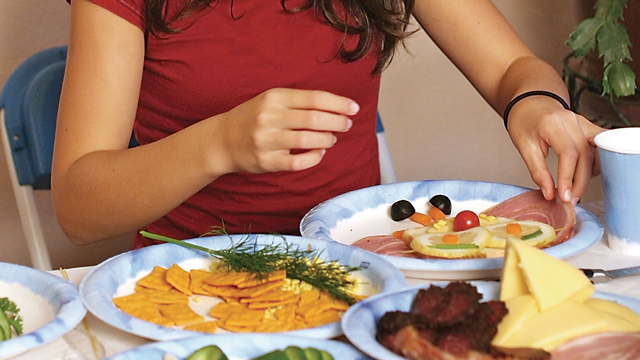When your child has been prescribed stimulant medication, it can be challenging to navigate their meals and snacks. As a pediatric dietitian, I work with kids who are prescribed stimulant medications as part of their treatment plan for ADHD, or attention-deficit/hyperactivity disorder. Someone with ADHD has differences in brain activity, causing challenges with attention or impulsivity, and stimulant medications can help manage ADHD symptoms.
It’s part of my job to work with families and develop strategies to help their child maintain good nutrition throughout this medication process. Every family is different, but these suggestions are a good place to start if your child’s medication affects his or her eating.
Stimulant Medication and Your Child’s Appetite
What usually happens when you get hungry? Your stomach might rumble or you might think about your favorite foods. When taking stimulant medication, a possible side effect is decreased appetite. When children take this medication daily, they might not pick up on hunger cues that signal to the body that it is time to refuel with food. Therefore, it takes some strategizing to ensure kids are getting enough nutrients to support optimal health and growth.
It’s important to schedule meals and snacks to work with your child’s medication schedule. Focus on breakfast and dinner as meals. It is typical for a child to take stimulant medication to help manage symptoms throughout the school day, meaning medication will impact appetite during this time. Plan a larger breakfast, eaten before your child takes their medication, and a larger dinner when their appetite has improved.
During midday, plan mini-meals or snacks if your child is not hungry for a full lunch. Eating every three to four hours can maintain blood sugar levels, which helps keep energy and mood consistent, supporting ADHD symptom management. For example, try scheduling a mid-morning snack, a small lunch, and an afternoon snack.
For older kids, who may be responsible for obtaining some of their own meals and snacks, alarms on phones or watches can be very helpful. For example, if your child comes home from school and starts working on other tasks, they might make it to the six o’clock dinner hour and realize the last time they ate was their late morning school lunch. A three o’clock snack alarm reminds a child it is time to refuel, even if they aren’t experiencing hunger cues.
Plan Nutritious Meals and Snacks
What should these meals and snacks include? Aim to offer a wide variety of food from all food groups, including fruits, veggies, protein sources, and whole grains. Keep in mind that every child and family is different, and there is no one way to have a healthful diet.
Here are a few tips to get you started:
• Protein is important because helps our body’s systems repair and build tissues. Protein also helps stabilize blood sugar, regulate energy and mood, and it provides building blocks for neurotransmitters, which are important brain-signaling molecules. Protein-rich foods include meat, eggs, dairy, tofu, nuts/nut butters, seeds, and beans. Try to include a source of protein during meals and snack-time.
• Midday mini-meals are a good idea if you know your child will not be particularly hungry during this time. Focus on foods that pack high energy and nutrients into every bite. Consider crackers with bean dip, cheese, guacamole, fortified cereal with milk, berries with full fat yogurt, apples with nut butter, nut butter on toast, eggs, or oatmeal made with milk. Liquid nutrition is also a great strategy. When someone isn’t feeling hungry, a shake or smoothie can be a great way to get nutrients. When someone has a low appetite, drinking something sounds better than looking at a plate of food. Remember to add a source of protein – such as yogurt, milk, or nut butter – to homemade smoothies.
• Vitamin C is important for health, and we should all try to consume it in the form of citrus fruits or bell peppers daily. However, it’s important to note that high doses of vitamin C/ascorbic acid or citric acid (a common preservative) can impact the effectiveness of some stimulant medications. Kids taking these medications should be mindful of consuming foods or supplements with a high concentration of vitamin C – such as orange juice, Emergen-C drink mix, or soft drinks with citric acid – within an hour of medication. Always read medication directions. Before starting any medication or supplement, talk with your doctor about possible interactions with food.
My hope is that some (or all!) of these strategies will be helpful for your family in figuring out a plan for meals and snacks when your child is taking stimulant medication. Every child is different, so if you have concerns about your child’s growth, diagnosis, or treatment plan, always let the doctor know. You can also contact a registered dietitian to discuss nutrition.




